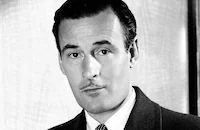Twelve to the Moon

Brief Synopsis
Cast & Crew
David Bradley
Ken Clark
Tom Conway
Tony Dexter
John Wengraf
Philip Baird
Film Details
Technical Specs
Synopsis
An international team embarks on an expedition to the moon in an uncommonly spacious rocketship. There they encounter a faceless alien intelligence who conclude that the human race is too immature and dangerous and must be destroyed.
Director
David Bradley
Videos
Movie Clip



Film Details
Technical Specs
Articles
Twelve to the Moon
Needless to say, their harmonious intentions run into a few speed bumps along the way as basic human territorial behavior comes into play (though not surprisingly, the American played by TV actor Ken Clark remains the most composed of the bunch). Caverns filled with air pockets, mysterious ice walls, and startling alien messages are just a few of the surprises in store, while the crew's additional animal passengers (pairs of cats, monkeys and canines) also come into play before the end after they've already dodged other menaces including a meteor shower. Of course, it soon transpires that the moon is already quite inhabited, thank you very much, and the residents are none too pleased with the latest trespassers.
Extremely strange and unpredictable, 12 to the Moon has the usual budget-deprived look of many second-tier science fiction films of the period, along with the expected avalanche of dubious science and plot holes larger than the moon's craters. Its reputation certainly suffered a major hit when it was used as one of many cinematic punching bags for Mystery Science Theater 3000, but the film provides more than ample entertainment value without the addition of wisecracking robots. One big surprise for movie buffs arrives in the opening scene with the entire setup for the plot delivered to the audience by Hollywood's first bona fide movie star, Francis X. Bushman, here playing "Secretary General of the International Space Order" (the kind of role normally given to an actor like Basil Rathbone).
Director David Bradley has only a small handful of films to his credit, but this one and its successor are certainly enough to enshrine him in the drive-in hall of fame. Apparently pleased with the Nazi subplot here which provides the most unlikely dramatic tension in the script, his next and final directorial effort came three years later with The Madmen of Mandoras (1963), a mind-melting concoction better known under its TV title, They Saved Hitler's Brain. Incredibly, his only other major films were 1950's Julius Caesar and 1941's Peer Gynt, both starring Charlton Heston.
Shot in just over a week for a reported $150,000, 12 to the Moon was released by Columbia in June of 1960 on a double bill with Ishirô Honda's Battle in Outer Space. The lack of a reasonable budget or star power doomed many science fiction films to obscurity after their initial runs, though this film managed to stay alive thanks to frequent television screenings (with and without Mike and the robots). Some of the more familiar cast members for eagle-eyed movie buffs include Japanese-American actress Michi Kobi (best known for the Jeffrey Hunter/David Janssen war film, Hell to Eternity, 1960), Norwegian TV actress Anna-Lisa, and Robert Montgomery, Jr. (College Confidential, 1960), son of Hollywood actor Robert Montgomery and brother of Bewitched's Elizabeth Montgomery, and Tom Conway, a regular in numerous Val Lewton horror classics such as Cat People (1942) and The Seventh Victim (1943). The Lewton connection continues to this film's screenwriter, DeWitt Bodeen, who wrote both of the two latter films as well as 1962's Billy Budd.
However, the most surprising member of 12 to the Moon's personnel is undoubtedly its cinematographer, John Alton, an innovative Hungarian-born iconoclast who earned an Academy Award® in 1952 for An American in Paris (1951). His demanding personality resulted in a patchwork career alternating between big studio films (Father of the Bride [1950], The Teahouse of the August Moon [1956], Elmer Gantry [1960]) and small programmers, though his work on the latter still produced remarkable results such as I, the Jury (1953),The Amazing Mr. X (1948) and The Big Combo (1955) -- proving that for some artists, no project is too big or too small.
Producer: Fred Gebhardt
Director: David Bradley
Screenplay: De Witt Bodeen; Fred Gebhardt (story)
Cinematography: John Alton
Art Direction: Rudi Feld
Music: Michael Andersen
Film Editing: Edward Mann
Cast: Ken Clark (Capt. John Anderson), Michi Kobi (Dr. Hideko Murata), Tom Conway (Dr. Feodor Orloff), Tony Dexter (Dr. Luis Vargas), John Wengraf (Dr. Erich Heinrich), Bob Montgomery, Jr. (Roddy Murdock), Phillip Baird (Dr. William Rochester), Richard Weber (Dr. David Ruskin), Tema Bey (Dr. Selim Hamid), Roger Til (Dr. Etienne Martel), Cory Devlin (Dr. Asmara Markonen), Anna-Lisa (Dr. Sigrid Bomark), Francis X. Bushman (Secretary General of the International Space Order).
BW-74m.
by Nathaniel Thompson

Twelve to the Moon
Quotes
Trivia
This low budget film with limited resources was, rather oddly, paired with Ishiro Honda's elaborate big budget sci-fi spectacle Uchu daisenso (1959) for its first US release.
Despite the overall low budget nature of this film, the producers obtained the services of the highly regarded cinematographer John Alton. This became one of two features shot by Alton during the final year of his active career. This did not indicate a decline in Alton's professional reputation; the other film shot that year was the far more upscale Elmer Gantry (1960).
This film was reportedly shot in 8 days on a budget of $150,000.














